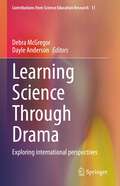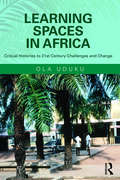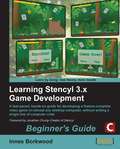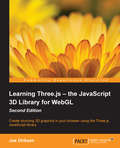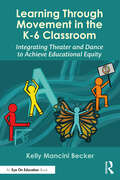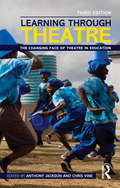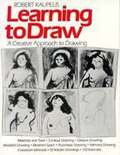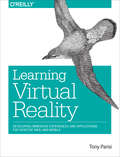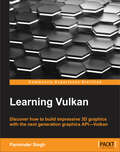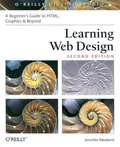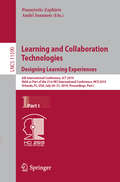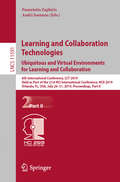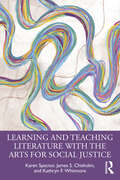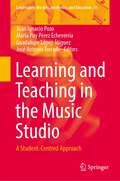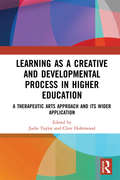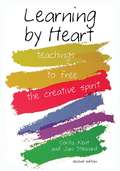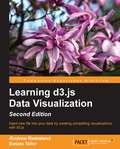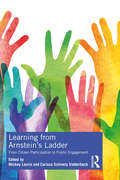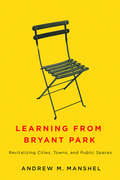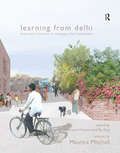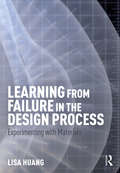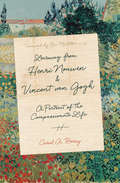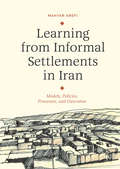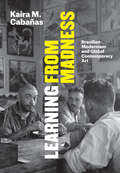- Table View
- List View
Learning Science Through Drama: Exploring international perspectives (Contributions from Science Education Research #11)
by Dayle Anderson Debra McGregorThis book presents a wide range of international perspectives that explore the different ways the diverse forms of drama supports learning in science. It illustrates how learning science by adopting and adapting theatrical techniques can offer more inclusive ways for students to relate to scientific ideas and concepts. The theatrical processes by which subject matter can be introduced, thought about, discussed, transformed, enacted and disseminated are shown to be endless. The first section of the book considers different ways of theorising and applying drama in classrooms. The second section provides a range of case studies illustrating how role play, performance, embodiment and enquiry approaches can be utilised for learning in primary, secondary and tertiary education contexts. The third section demonstrates how different research methods from questionnaires, particular kinds of tests and even the theatrical conventions themselves can provide rich data that informs how drama impacts on learning science.
Learning Spaces in Africa: Critical Histories to 21st Century Challenges and Change
by Ola UdukuWith a key UN Sustainable Development Goal for 2030 being to make basic education available to all the world’s children, Learning Spaces in Africa explores the architectural, socio-political and economic policy factors that have contributed to school design, the main spaces for education and learning in Africa. It traces the development of school building design, focusing on Western and Southern Africa, from its emergence in the 19th century to the present day. Uduku’s analysis draws attention to the past historic links of schools to development processes, from their early 19th century missionary origins to their re-emergence as development hubs in the 21st century. Learning Spaces in Africa uses this research as a basis to suggest fundamental changes to basic education, which respond to new technological advances, and constituencies in learning. Illustrated case studies describe the use of tablets in refugee community schools, "hole-in-the wall" learning and shared school-community learning spaces. This book will be beneficial for students, academics and those interested in the history of educational architecture and its effect on social development, particularly in Africa and with relevance to countries elsewhere in the emerging world.
Learning Stencyl 3.x Game Development: Beginner's Guide
by Innes BorkwoodA step-by-step, practical tutorial with a no-nonsense approach. The book starts by showing readers how to create a playable game that is fully-functioning, then moves on to demonstrate how to fine-tune the game with eye-catching graphics techniques, audio-effects and more.This book is for indie and existing game developers and those who want to get started with game development using Stencyl. Some understanding of Objective-C, C++, and game development basics is recommended. People with some programming experience may also find this book useful.
Learning Three.js – the JavaScript 3D Library for WebGL - Second Edition
by Jos DirksenIf you know JavaScript and want to start creating 3D graphics that run in any browser, this book is a great choice for you. You don't need to know anything about math or WebGL; all that you need is general knowledge of JavaScript and HTML.
Learning Through Movement in the K-6 Classroom: Integrating Theater and Dance to Achieve Educational Equity
by Kelly Mancini BeckerThis book offers a creative and practical guide for K-6 teachers on how to effectively integrate movement into the curriculum to increase student engagement, deepen learning, improve retention, and get kids moving during the school day. Chapters offer concrete ideas for integrating creative movement and theater into subjects such as math, science, literacy, and social studies. Drawing on two decades of experience, Dr. Becker outlines key skills, offers rich examples, and provides adaptable and flexible classroom tested lesson plans that align with Common Core Standards, the NGSS, C3 Social Studies Standards, and the National Core Arts Standards. Activities are grounded in arts integration, which is steadily gaining interest in school reform as an effective teaching strategy that increases student outcomes academically and socially—particularly effective for students who have traditionally been marginalized. This book will benefit practicing educators who want to invigorate their practice, preservice teachers who want to expand their toolkit, and school leaders looking to employ policies that support movement and arts during the school day. Jump in and get your kids Learning Through Movement and see how active and engaging learning can be!
Learning Through Movement in the K-6 Classroom: Integrating Theater and Dance to Achieve Educational Equity
by Kelly Mancini BeckerThis book offers a creative and practical guide for K-6 teachers on how to effectively integrate movement into the curriculum to increase student engagement, deepen learning, improve retention, and get kids moving during the school day.Chapters offer concrete ideas for integrating creative movement and theater into subjects such as math, science, literacy, and social studies. Drawing on two decades of experience, Dr. Becker outlines key skills, offers rich examples, and provides adaptable and flexible classroom tested lesson plans that align with Common Core Standards, the NGSS, C3 Social Studies Standards, and the National Core Arts Standards. Activities are grounded in arts integration, which is steadily gaining interest in school reform as an effective teaching strategy that increases student outcomes academically and socially—particularly effective for students who have traditionally been marginalized.This book will benefit practicing educators who want to invigorate their practice, preservice teachers who want to expand their toolkit, and school leaders looking to employ policies that support movement and arts during the school day. Jump in and get your kids Learning Through Movement and see how active and engaging learning can be!
Learning Through Theatre: The Changing Face of Theatre in Education
by Chris Vine Anthony JacksonIn the two decades since the publication of the second edition, Learning Through Theatre has further established itself as an indispensable resource for scholars, practitioners and educators interested in the complex interrelations between teaching and learning, the performing arts, and society at large. Theatre in Education (TIE) has consistently been at the cutting edge of the ever-growing field of Applied Theatre; this comprehensively revised new edition makes an international case for why, and how, it will continue to shape ways in which the participatory arts contribute to the learning of young people (and increasingly, adults) in the 21st century. Drawing on the experiences and insights of theorists and practitioners from across the world, Learning Through Theatre shows how theatre can, and does, promote: participatory engagement; the use of innovative theatrical form; work with young people and adults in a range of educational settings; and social and personal change. Now transatlantically edited by Anthony Jackson and Chris Vine, Learning Through Theatre offers exhilarating new reflections on the book’s original aim: to define, describe and debate the salient features, and wider political context, of one of the most important – and radical – developments in contemporary theatre.
Learning To Draw
by Robert KaupelisFull of inventive and stimulating projects designed to develop observation skills and creativity, this book approaches drawing as a process of personal discovery through improvisation. Richly illustrated with drawings by old and modern masters.
Learning Virtual Reality: Developing Immersive Experiences and Applications for Desktop, Web, and Mobile
by Tony ParisiAs virtual reality approaches mainstream consumer use, a vibrant development ecosystem has emerged in the past few years. This hands-on guide takes you through VR development essentials for desktop, mobile, and browser-based applications. You’ll explore the three go-to platforms—OculusVR, Gear VR, and Cardboard VR—as well as several VR development environments, programming tools, and techniques.If you’re an experienced programmer familiar with mobile development, this book will help you gain a working knowledge of VR development through clear and simple examples. Once you create a complete application in the final chapter, you’ll have a jumpstart on the next major entertainment medium.Learn VR basics for UI design, 3D graphics, and stereo renderingExplore Unity3D, the current development choice among game enginesCreate native applications for desktop computers with the Oculus RiftDevelop mobile applications for Samsung’s Gear VR with the Android and Oculus Mobile SDKsBuild browser-based applications with the WebVR Javascript API and WebGLCreate simple and affordable mobile apps for any smartphone with Google’s Cardboard VRBring everything together to build a 360-degree panoramic photo viewer
Learning Vulkan
by Parminder SinghDiscover how to build impressive 3D graphics with the next-generation graphics API—Vulkan About This Book • Get started with the Vulkan API and its programming techniques using the easy-to-follow examples to create stunning 3D graphics • Understand memory management in Vulkan and implement image and buffer resources • Get hands-on with the drawing process and synchronization, and render a 3D graphics scene with the Vulkan graphics pipeline Who This Book Is For This book is ideal for graphic programmers who want to get up and running with Vulkan. It's also great for programmers who have experience with OpenGL and other graphic APIs who want to take advantage of next generation APIs. A good knowledge of C/C++ is expected. What You Will Learn • Learn fundamentals of Vulkan programing model to harness the power of modern GPU devices. • Implement device, command buffer and queues to get connected with the physical hardware. • Explore various validation layers and learn how to use it for debugging Vulkan application. • Get a grip on memory management to control host and device memory operations. • Understand and implement buffer and image resource types in Vulkan. • Define drawing operations in the Render pass and implement graphics pipeline. • Manage GLSL shader using SPIR-V and update the shader resources with descriptor sets and push constants. • Learn the drawing process, manage resources with synchronization objects and render 3D scene output on screen with Swapchain. • Bring realism to your rendered 3D scene with textures, and implement linear and optimal textures In Detail Vulkan, the next generation graphics and compute API, is the latest offering by Khronos. This API is the successor of OpenGL and unlike OpenGL, it offers great flexibility and high performance capabilities to control modern GPU devices. With this book, you'll get great insights into the workings of Vulkan and how you can make stunning graphics run with minimum hardware requirements. We begin with a brief introduction to the Vulkan system and show you its distinct features with the successor to the OpenGL API. First, you will see how to establish a connection with hardware devices to query the available queues, memory types, and capabilities offered. Vulkan is verbose, so before diving deep into programing, you'll get to grips with debugging techniques so even first-timers can overcome error traps using Vulkan's layer and extension features. You'll get a grip on command buffers and acquire the knowledge to record various operation commands into command buffer and submit it to a proper queue for GPU processing. We'll take a detailed look at memory management and demonstrate the use of buffer and image resources to create drawing textures and image views for the presentation engine and vertex buffers to store geometry information. You'll get a brief overview of SPIR-V, the new way to manage shaders, and you'll define the drawing operations as a single unit of work in the Render pass with the help of attachments and subpasses. You'll also create frame buffers and build a solid graphics pipeline, as well as making use of the synchronizing mechanism to manage GPU and CPU hand-shaking. By the end, you'll know everything you need to know to get your hands dirty with the coolest Graphics API on the block. Style and approach This book takes a practical approach to guide you through the Vulkan API, and you will get to build an application throughout the course of the book. Since you are expected to be familiar with C/C++, there is not much hand-holding throughout the course of the book.
Learning Web Design, 2nd Edition
by Jennifer Niederst RobbinsIn Learning Web Design , author Jennifer Niederst shares the knowledge she's gained from years of web design experience, both as a designer and a teacher. This book starts from the beginning-- defining the Internet, the Web, browsers, and URLs -- so you don't need to have any previous knowledge about how the Web works. After reading this book, you'll have a solid foundation in HTML, graphics, and design principles that you can immediately put to use in creating effective web pages. In the second edition, Jennifer has updated the book to cover style sheets and reflect current web standards. She has also added exercises that help you to learn various techniques and short quizzes that make sure you're up to speed with key concepts. The companion CD-ROM contains material for all the exercises in the book, as well as trial versions of Fireworks MX, and HomeSite 5; Adobe Photoshop 7, ImageReady 7, and BBEdit 7.* Learning Web Design , 2nd Edition: Covers the nuts and bolts of basic HTML and style sheets, with detailed examples of formatting text, adding graphic elements, making links, creating tables and frames, and using color on the Web. Explains whether to use GIFs or JPEGs for different types of images, and includes important tips on optimizing graphics for web delivery. Provides dozens of web design do and don'ts, to help you make good web design decisions and avoid common beginner traps. Contains hands-on exercises throughout the book that allow you to try out new techniques along the way. Unlike other beginner books, Learning Web Design leaves no holes in your education. It gives you everything you need to create basic web sites and will prepare you for more advanced web work. If you are interested in web design, this book is the place to start. After finishing it, you'll be ready for the author's bestselling companion reference, Web Design in a Nutshell . * Fireworks and HomeSite are trademarks or registered trademarks of Macromedia, Inc. in the United States and/or other countries. Adobe, ImageReady, and Photoshop are either registered trademarks or trademarks of Adobe Systems Incorporated in the United States and/or other countries.
Learning and Collaboration Technologies. Designing Learning Experiences: 6th International Conference, LCT 2019, Held as Part of the 21st HCI International Conference, HCII 2019, Orlando, FL, USA, July 26–31, 2019, Proceedings, Part I (Lecture Notes in Computer Science #11590)
by Panayiotis Zaphiris Andri IoannouThis two-volume set LNCS 11590 and 11591 constitutes the refereed proceedings of the 6th International Conference on Learning and Collaboration Technologies, LCT 2019, held as part of the 21st International Conference on Human-Computer Interaction, HCII 2019, in Orlando, FL, USA in July 2019. The 1274 full papers and 209 posters presented at the HCII 2019 conferences were carefully reviewed and selected from 5029 submissions. The papers cover the entire field of human-computer interaction, addressing major advances in knowledge and effective use of computers in a variety of applications areas. The papers in this volume are organized in the following topical sections: designing and evaluating learning experiences; theoretical and pedagogical approaches in technology-enhanced learning; cognitive and psychological issues in learning; and technology in STEM education.
Learning and Collaboration Technologies. Ubiquitous and Virtual Environments for Learning and Collaboration: 6th International Conference, LCT 2019, Held as Part of the 21st HCI International Conference, HCII 2019, Orlando, FL, USA, July 26–31, 2019, Proceedings, Part II (Lecture Notes in Computer Science #11591)
by Panayiotis Zaphiris Andri IoannouThis two-volume set LNCS 11590 and 11591 constitutes the refereed proceedings of the 6th International Conference on Learning and Collaboration Technologies, LCT 2019, held as part of the 21st International Conference on Human-Computer Interaction, HCII 2019, in Orlando, FL, USA in July 2019. The 1274 full papers 209 posters presented at the HCII 2019 conferences were carefully reviewed and selected from 5029 submissions. The papers cover the entire field of human-computer interaction, addressing major advances in knowledge and effective use of computers in a variety of applications areas. The papers in this volume are organized in the following topical sections: mobile and ubiquitous learning; virtual reality and augmented reality systems for learning; and collaborative technology.
Learning and Teaching Literature with the Arts for Social Justice
by James S. Chisholm Kathryn F. Whitmore Karen SpectorThis text invites pre-service teachers to explore arts-informed practices that showcase the transformative potential of literature in the classroom. Through the lens of "stories-we-live-by," the authors recognize literature as interference, capable of disrupting the habitual patterns through which we interpret the world in order to reawaken the capacity of students and teachers alike to change. Chapters are designed to inspire students’ love of literature by fostering literary and artful encounters that provoke their thinking and sense-making. Each chapter includes engaging pedagogical features that spark thinking and analysis of literature and invite readers to further engagement. The appendices include directions for instruction as well as additional resources. An essential text for courses on children’s and adolescent literature and English methods, pre-service teachers will come away with plenty of text recommendations and arts- and social justice-informed practices to use with their future students. Through artful encounters with visual learning analyses, visual-verbal journals, drama, soundscapes, poetry, and so much more, readers examine their own transformative experiences with literature. Readers will learn to craft and curate practices that encourage engagement, imagination, experimentation, and self-awareness in and beyond the classroom.
Learning and Teaching in the Music Studio: A Student-Centred Approach (Landscapes: the Arts, Aesthetics, and Education #31)
by Juan Ignacio Pozo María Puy Pérez Echeverría Guadalupe López-Íñiguez José Antonio TorradoThis book advocates for a radical change in music teaching and learning methods, allowing for a break from the traditional conservatory model still in use in many classrooms. The product of twenty years of interdisciplinary work by musicians, music teachers, and psychologists, the book proposes to place the focus of music education on the students themselves and on their mental and physical activity, with the aim of helping them to manage their own goals and emotions. This alternative is based on a new theoretical framework, as well as numerous real, concrete examples of how to put it into practice with students of different ages and in different environments. This book focuses primarily on teaching instrumental music, but its content will be useful for any teacher, student, musician, or researcher interested in improving music education in any environment, whether formal or informal, in which it takes placeChapters 3, 4, 6 and 18 are available open access under a Creative Commons Attribution 4.0 International License via link.springer.com.
Learning as a Creative and Developmental Process in Higher Education: A Therapeutic Arts Approach and Its Wider Application
by Clive Holmwood Judie TaylorMuch has been written about the importance of creativity in learning and education over the last few decades. This unique book extends beyond the usual focus on implementing creative methods in learning, teaching and assessing within higher education, to an examination of creativity as central to a learning process which is transformational for the student. More specifically, Learning as a Creative and Developmental Process in Higher Education examines the importance of a facilitative tutor-student relationship and environment which contextualise this creative process of teaching and learning. Bringing together unique teaching and learning approaches developed by experienced academics, this book discusses a number of complex issues, including approaches to an understanding of the student’s self-concept as learner; the nature of the curriculum; the potential of metaphor and creativity; and a multi-modal approach to learning and teaching. Contributions to the book also examine some of the challenges and tensions of such an approach within the context of arts-based subjects in higher education institutions. Using a unique and coherent thematic structure that is based upon the student journey as a transformational process, this book provides a new way of understanding the student journey through higher education. Including an examination of the parallels between educational and arts education and arts therapies disciplines, this book will be of interest to researchers, academics and postgraduate students involved in the arts and the arts therapies, as well as those studying creativity in teaching and learning in higher education. It should be of particular interest to those involved in the teaching and training of teachers and lecturers in higher education.
Learning by Heart: Teachings to Free the Creative Spirit
by Corita Kent Jan StewardTap into your natural ability to create!* Engaging, proven exercises for developing creativity* Priceless resource for teachers, artists, actors, everyoneArtist and educator Corita Kent inspired generations of artists, and the truth of her words "We can all talk, we can all write, and if the blocks are removed, we can all draw and paint and make things" still shines through. This revised edition of her classic work Learning by Heart features a new foreword and a chart of curriculum standards. Kent's original projects and exercises, developed through more than 30 years as an art teacher and richly illustrated with 300 thought-provoking images, are as inspiring and as freeing today as they were during her lifetime. Learn how to challenge fears, be open to new directions, recognize connections between objects and ideas, and much more in this remarkable, indispensable guide to freeing the creative spirit within all of us. With new material by art world heavyweights Susan Friel and Barbara Loste, Learning by Heart brings creative inspiration into the 21st century!
Learning d3.js Data Visualization - Second Edition
by Swizec Teller Ændrew RininslandInject new life into your data by creating compelling visualizations with d3.js About This Book * Understand how to best represent your data by developing the right kind of visualization * Harness the power of D3 by building interactive and real-time data-driven web visualizations * This book will provide a strong foundation in designing compelling web visualizations with D3.js Who This Book Is For This book is for web developers, data scientists, and anyone interested in representing data through interactive visualizations on the web with D3. Some basic JavaScript knowledge is expected, but no prior experience with data visualization or D3 is required to follow this book. What You Will Learn * Gain a solid understanding of the common D3 development idioms * Be able to input data, transform it, and output it as a visualization * Add simple effects and user interactions to a visualization * Find out how to write basic D3 code for server using Node.js * Automate testing visualizations using Mocha * Achieve fluency in ES2015, the most modern version of JavaScript In Detail D3 has emerged as one of the leading platforms to develop beautiful, interactive visualizations over the web. We begin by setting up a strong foundation, then build on this foundation book will take you through the entire world of reimagining data using interactive, animated visualizations created in D3.js. In addition to covering the various features of D3.js to build a wide range of visualizations, we also focus on the entire process of representing data through visualizations so that developers and those interested in data visualization will get the entire process right. We also include chapters that explore a wide range of visualizations through practical use cases. By the end of this book, you will have unlocked the mystery behind successful data visualizations and will be ready to use D3 to transform any data into a more engaging and sophisticated visualization. Style and approach This book has comprehensive explanation on how to leverage the power of D3.js to create powerful and creative visualizations through step by step instruction
Learning from Arnstein's Ladder: From Citizen Participation to Public Engagement
by Mickey Lauria and Carissa Schively SlotterbackSherry Arnstein, writing in 1969 about citizen involvement in planning processes in the United States, described a “ladder of citizen participation” that showed participation ranging from low to high. Arnstein depicted the failings of typical participation processes at the time and characterized aspirations toward engagement that have now been elevated to core values in planning practice. But since that time, the political, economic, and social context has evolved greatly, and planners, organizers, and residents have been involved in planning and community development practice in ways previously unforeseen. Learning from Arnstein’s Ladder draws on contemporary theory, expertise, empirical analysis, and practical applications in what is now more commonly termed public engagement in planning to examine the enduring impacts of Arnstein’s work and the pervasive challenges that planners face in advancing meaningful public engagement. This book presents research from throughout the world, including Australia, Brazil, India, Indonesia, Portugal, Serbia, and the United States, among others, that utilizes, critiques, revises, and expands upon Arnstein’s aspirational vision. It is essential reading for educators and students of planning.
Learning from Bryant Park: Revitalizing Cities, Towns, and Public Spaces
by Andrew M. ManshelBy the 1970s, 42nd Street in New York was widely perceived to be unsafe, a neighborhood thought to be populated largely by drug dealers, porn shops, and muggers. But in 1979, civic leaders developed a long-term vision for revitalizing one especially blighted block, Bryant Park. The reopening of the park in the 1990s helped inject new vitality into midtown Manhattan and served as a model for many other downtown revitalization projects. So what about urban policy can we learn from Bryant Park? In this new book, Andrew M. Manshel draws from both urbanist theory and his first-hand experiences as a urban public space developer and manager who worked on Bryant Park and later applied its strategies to an equally successful redevelopment project in a very different New York neighborhood: Jamaica, Queens. He candidly describes what does (and doesn’t) work when coordinating urban redevelopment projects, giving special attention to each of the many details that must be carefully observed and balanced, from encouraging economic development to fostering creative communities to delivering appropriate services to the homeless. Learning from Bryant Park is thus essential reading for anyone who cares about giving new energy to downtowns and public spaces.
Learning from Delhi: Dispersed Initiatives in Changing Urban Landscapes
by Written by Mitchell Shamoon PatwariThe inflexibility of modern urban planning, which seeks to determine the activities of urban inhabitants and standardise everyday city life, is challenged by the unstoppable organic growth of illegal settlements. In rapidly expanding cities, issues of continuity with local traditions, local conditions and local ways of working are juxtaposed with those of abrupt change due to emergency, reaction to modernity, environmental degradation, global market forces and global technological imperatives to make efforts to control by physical planning redundant as soon as they are enacted. In most third world cities there is little social welfare and almost no attempt at social housing. The urban poor must still house themselves with little or no state help to procure land or infrastructure. Not having a legal existence, 'slums' are automatically swept away to create a 'tabula rasa' prior to a complete new build for those who can afford the full cost. The notion of upgrading the existing built environment, has hardly entered the official planning vocabulary. Since 2002, both Diploma and latterly Degree students from London Metropolitan University Department of Architecture and Spatial Design have produced schemes from research work generated during an annual field trip to India. Work is focused on situations where rapid cultural and technical change is affecting traditional or transitional communities who have access to only limited resources. Sites have included post earthquake desert locations in Gujarat, under-serviced urban slums in Delhi, dense traditional city landscapes in Meerut and the integration of Marwari nomads into a settlement in Agra. This has proved a stimulating and provocative academic learning environment producing a range of innovative work. Some of the students involved have been awarded RIBA medals and other prestigious student prizes. In the course of this enterprise, links with Indian non-government organisations and architectural schools have developed providing a wealth of opportunity for further work, including a new MA and, while a first live project which will provide sanitation to a low income urban village in Agra is nearing completion, two other live projects: for primary education in a stone quarry near Mumbai and for a housing cooperative in north west Delhi, are just beginning. The course has been ground breaking and innovative in this area in that it seeks first to understand the cultural and physical patterns of old city labyrinths and illegal urban settlements before, and as an aid to, intervention. Extended physical and cultural surveys which up date the 'diagnostic' surveys first employed by Patrick Geddes in the early 20th century are carried out by the students. By understanding the historical, cultural and physical factors which underlie the current city fabric, students are able to propose and validate a range of schemes from simple conservative surgery carried out by the community alone, to working alongside cultures of resistance to provide alternatives to planned projects. They have also shown how major infrastructure projects can be tweaked in practice to add greater potential to those who use them. Unlike master planning this understanding does not seek to lay down a fossilised grid within which inhabitants must fit themselves. Rather than this, students design using a narrative approach to frame, capture and harness (however fleetingly) moments from the everyday to use as building blocks for their imagined proposals. Their schemes show how an 'untidy' mix of the old and the new, of memory and aspiration can, in a spirit of experiment and curiosity, give unique identity to place. Cities are in a process of constant renewal. The piecemeal reuse and adaptation of the existing urban fabric in an attempt to match the changing aspirations of its inhabitants is cost effective, environmentally sustainable and appropriate. The book is about this increasingly vital type of architectural work. It is also a testimony to the value of linking real live projects with education in the studio
Learning from Failure in the Design Process: Experimenting with Materials
by Lisa HuangLearning from Failure in the Design Process shows you that design work builds on lessons learned from failures to help you relax your fear of making mistakes, so that you’re not paralyzed when faced with a task outside of your comfort zone. Working hands-on with building materials, such as concrete, sheet metal, and fabric, you will understand behaviors, processes, methods of assembly, and ways to evaluate your failures to achieve positive results. Through material and assembly strategies of stretching, casting, carving, and stacking, this book uncovers the issues, problems, and failures confronted in student material experiments and examines built projects that addressed these issues with innovative and intelligent strategies. Highlighting numerous professional practice case studies with over 250 color images, this book will be ideal for students interested in materials and methods, and students of architecture in design studios.
Learning from Henri Nouwen and Vincent van Gogh: A Portrait of the Compassionate Life
by Carol A. BerryCarol Berry and her husband met and befriended Henri Nouwen when she sat in his course on compassion at Yale Divinity School in the 1970s. At the request of Henri Nouwen's literary estate, she has written this book, which includes unpublished material recorded from Nouwen's lectures. As an art educator, Berry is uniquely situated to develop Nouwen's work on Vincent van Gogh and to add her own research. She fills in background on the much misunderstood spiritual context of van Gogh's work, and reinterprets van Gogh's art (presented here in full color) in light of Nouwen's lectures. Berry also brings in her own experience in ministry, sharing how Nouwen and van Gogh, each in his own way, led her to the richness and beauty of the compassionate life.
Learning from Informal Settlements in Iran: Models, Policies, Processes, and Outcomes
by Mahyar ArefiThis book explores the tenacity of Iran’s informal settlements against the backdrop of the World Bank’s USD 80 million loan for physical upgrading. Arefi seeks to identify and unravel the distinctive models, policies, processes, and outcomes associated with it, and explains why—despite obvious challenges—informal settlements remain popular in Iran, and also how understanding them in a broader theoretical context helps rectify existing redevelopment policies in order to develop more effective ones.
Learning from Madness: Brazilian Modernism and Global Contemporary Art
by Kaira M. CabañasThroughout the history of European modernism, philosophers and artists have been fascinated by madness. Something different happened in Brazil, however, with the “art of the insane” that flourished within the modernist movements there. From the 1920s to the 1960s, the direction and creation of art by the mentally ill was actively encouraged by prominent figures in both medicine and art criticism, which led to a much wider appreciation among the curators of major institutions of modern art in Brazil, where pieces are included in important exhibitions and collections. Kaira M. Cabañas shows that at the center of this advocacy stood such significant proponents as psychiatrists Osório César and Nise da Silveira, who championed treatments that included painting and drawing studios; and the art critic Mário Pedrosa, who penned Gestaltist theses on aesthetic response. Cabañas examines the lasting influence of this unique era of Brazilian modernism, and how the afterlife of this “outsider art” continues to raise important questions. How do we respect the experiences of the mad as their work is viewed through the lens of global art? Why is this art reappearing now that definitions of global contemporary art are being contested?Learning from Madness offers an invigorating series of case studies that track the parallels between psychiatric patients’ work in Western Europe and its reception by influential artists there, to an analogous but altogether distinct situation in Brazil.
